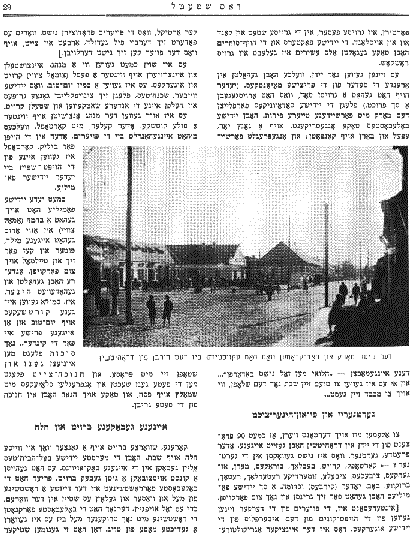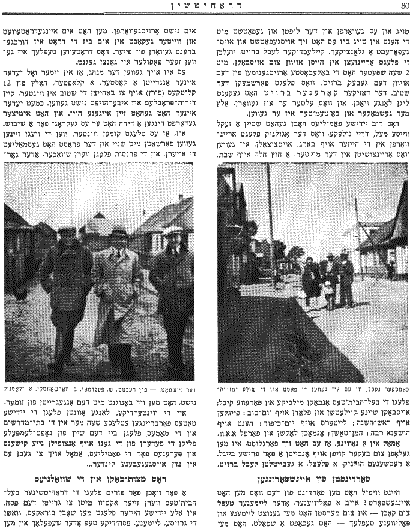Previous Page
|
Next Page
 [
Page 29
]
[
Page 29
]
transport the products in huge barrels to large cities in Russia and abroad.
These Jewish businessmen were very wealthy and lived well. Other Jews were
involved in managing the orchards of the landowners' manors (every estate had
its own large orchard that produced alot of fruit). The Jewish orchard managers
supplied the market with various precious fruit. The Jewish householders were
able to have a supply of apples and pears for their fruit compote for the
entire year. They were able to make jams and jellies, and used to say "We
just shouldn't need it." It was eaten on the Sabbath following the
afternoon nap, and offered to guests.
Gardening and Raising Cattle and Poultry
It should be mentioned that almost 90 percent of the Jews in Drohitchin tended
their own, or someone else's, garden. Everything grew in those gardens:
potatoes, cabbage, beans, beets, carrots, cucumbers, scallions, onions, white
radishes, red radishes, turnips, green beans, pumpkins, etc. Many Jewish
families had enough vegetables for themselves and to sell to others.
It's interesting that the
peasants from the villages were the main buyers of the surplus of cucumbers
sold by the Jews. This was the only agricultural product that the peasants
didn't grow themselves, because it required alot of patience, work and time,
which the peasants didn't have.
The usual custom was to make
pickles and sauerkraut, and store it in a barrel or two for the winter. When
Jewish women used to get together to help their neighbors pickle cabbage, there
was a holiday atmosphere. There was also the custom of filling up the cellar or
yard with potatoes bought from the peasants at low prices. Potatoes were one of
the main foods of every Jewish family.
Almost every Jewish family also
had a cow or two, and were therefore able to produce their own milk, butter and
cheese, and some extra to sell. Others raised hens, and were thus able to have
chicken for the Jewish festivals and fresh eggs for the children. After Sukkot,
people would catch geese and fatten them with grain, and at Chanukah time they
would slaughter the fattened geese, and for Passover would fry them up with
fat. Fried goose skins were also enjoyed during Chanukah.
Home-baked bread and challah
Most of the Jewish housewives
used to bake black rye bread for the week, and white challah for the Sabbath in
their own ovens. It was a form of art to create well-baked bread. First, the
housewives would leaven flour and water in the leavening trough and let it get
it warm and rise. Afterwards, the housewives would knead the dough until it
became nice and thick. Then they took pieces of
 [
Page 30
]
[
Page 30
]
of dough and threw it up in the air and started punching it with their hands
until it formed a shining smooth loaf of bread, which they then placed into the
waiting hot oven to be baked. Two hours later they removed the freshly baked
bread from the oven, and would fill the house with it aroma. The rye bread
could stay good for weeks, and the older it got, the tastier and more delicious
it became.
Most Jewish families had a sack
of white flour and three iceboxes that the deliveryman would bring to the
house, and would offer credit terms for payment. Thus, it was possible to make
bread dough. In addition to a challah for the Sabbath, the housewives used to
bake milk and pareve cookies, twisted challah bread and fruit cakes for the
festivals; rolls for Rosh Hashanah; ladders for Yom Kippur; hands for Hoshanah
Rabba [last day of Sukkot]; Hamentashen for Purim, as well as noodles and
farfel, etc.
Once in a while, people used to
go to the baker to buy a couple of fresh bagels for lunch, a buckwheat bun, a
cracker or a pure white round bread roll.
[Photo:] Khomsk Alley, where the post office and the Mechayeh School were
located.
Earning money from savings
Nowadays, how much money do people make from what they save? If a ceramic or
clay cooking pot (most people used clay or ceramic pots) was cracked, no one
just threw it out. It was repaired and used over and over again, until the wire
started to stick through it because of repeated heating. Those wire pots were
very popular in the whole region.
There was also the custom in
the summer of preparing a cord of 12 loads of wood for warming the house during
the winter. There were no housing problems. Almost every person had his own
house, and if anyone had to rent an apartment, he could find it for a pittance.
[Photo:] The new town – on
the right: S. Feldman, B. Warshavsky, A. Zlotnick
With the arrival of winter,
when the roads were covered in snow, frost burned your eyes, and it was harder
to earn a living, or livelihoods were non-existent, you were satisfied with
preparing for summer. During the long winter evenings, Jewish fathers would
spend a few more hours in the houses of study, while mothers would sit by oil
lamps and pluck goose feathers to use to fill new cushions and featherbeds for
their families. Sometimes they made them for dowries for their engaged children.
Baking Matzah and the workshops
A couple of weeks before Purim, Drohitchin housewives started getting busy with
preparations for Passover. People used to start scraping beets, washing the
large clay Passover pots or cupboards, and
Previous Page
|
Next Page
This material is made available by JewishGen, Inc.
and the Yizkor Book Project for the purpose of
fulfilling our
mission of disseminating information about the Holocaust and
destroyed Jewish communities.
This material may not be copied,
sold or bartered without JewishGen, Inc.'s permission. Rights may be
reserved by the copyright holder.
JewishGen, Inc. makes no representations regarding the accuracy of
the translation. The reader may wish to refer to the original material
for verification.
JewishGen is not responsible for inaccuracies or omissions in the original work and cannot rewrite or edit the text to correct inaccuracies and/or omissions.
Our mission is to produce a translation of the original work and we cannot verify the accuracy of statements or alter facts cited.
 Drogichin, Belarus
Drogichin, Belarus
 Yizkor Book Project
Yizkor Book Project
 JewishGen Home Page
JewishGen Home Page
Yizkor Book Director, Lance Ackerfeld
This web page created by Lance Ackerfeld
Copyright © 1999-2025 by JewishGen, Inc.
Updated 3 Dec 2001 by LA
 [
Page 29
]
[
Page 29
]



